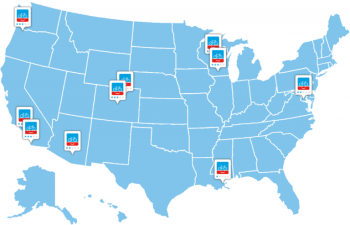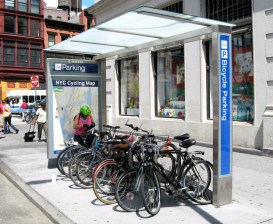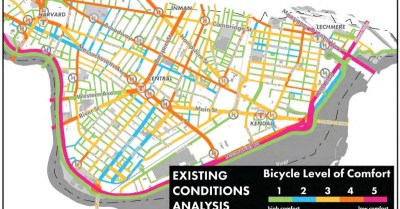Only Part of the City is Bike-Friendly

New York City is a great place to bike — but only in Manhattan and Brooklyn, according to a new report from bicycle advocacy group, PeopleForBikes.
The group ranked the “most bikeable places” in America for the second year in a row, and only two of the five boroughs made the cut. The three boroughs that didn’t are experiencing double-digit increases in fatalities and injuries to cyclists.
The whole Big Apple came in 11th place in 2018, but this year, PeopleForBikes ranked each borough separately after the Department of Transportation said that the single rank for such a large and geographically diverse city didn’t do justice to all the various efforts in different communities.
“By considering all of the five boroughs as one entry in the system, it left out a little bit of the nuance about borough-specific projects and programs happening there,” said the group’s Director of local Innovation Kyle Wagenschutz. ”The success of what’s working in Manhattan and Brooklyn … was overshadowing the lack of progress being made in the Bronx and Staten Island and … parts of Queens — and left advocates feeling like the benchmarks were a bit too broad and generic.”
It’s not just the benchmarks that are the problem. Road design is crucial to the success of Mayor de Blasio’s Vision Zero initiative — but critics say the effort has stalled, with fatalities up overall this year.
Fatalities and injuries are soaring in parts of the city that have been largely untouched by Vision Zero, including the three shunned boroughs. As a result, fatalities in Queens, the Bronx and Staten Island are up 16 percent so far this year, compared to the same period last year. Injuries to cyclists are up 15 percent. And total injuries are up 2 percent, according to police statistics.
In southern Brooklyn, which also lags behind the rest of the hipster borough and its neighboring borough to the east, fatalities have doubled so far this year, and injuries to cyclists are up nearly 17 percent, city stats show.
New York was the only city out of the 510 surveyed that was broken down into smaller municipalities. Both Manhattan and Brooklyn fell safely in the top 10 across the country — Manhattan ranked fourth, and Brooklyn seventh.
Queens made it into the top 20, coming in 16th place, but the Bronx and Staten Island — both underserved boroughs that get the short end of the street-safety stick — barely ranked amongst the top 50, with the Bronx coming in at 45 and the The Rock at 51.
The report underscores the desperate need for more street improvements.
“In some ways it makes places like Manhattan and Brooklyn rise in the scores because all success in the past, and it showcases that there’s still a lot of work to do particularly in the Bronx,” said Wagenschutz.

And the ratings seem pretty obvious if you were to compare them to the city’s bike network — which is built out significantly in Manhattan’s Central Business District, but then flickers out as it moves east and north, according to Bike New York’s Jon Orcutt.
“If you’re looking at the city bike map [PDF], it’s very apparent there are big distinctions geographically,” he said. “I think even between Manhattan and Brooklyn, in terms of protected bike lanes, Manhattan is off the charts. Manhattan really stands out with the quantity and connectivity of its protected bike lanes.”
Orcutt says the drastically different ratings by borough should remind the city to do more, but he also blamed the poor ratings for the Bronx and Staten Island on communities that choose parking over life-saving road redesigns. In Queens and upper Manhattan, for example, Mayor de Blasio ended up overruling community boards’ objection to street safety plan — but the delays led to hundreds of injuries and several deaths.
“In some ways it’s easier to do protected bike lanes in the Manhattan central business district because the NIBMYism in rest of the city is much more intense in some residential areas,” said Orcutt, a former DOT official. “In order to build Queens Boulevard and Skillman Avenue, the city has had to overrule the community boards.”
The Department of Transportation revealed back in December that it fell short of its own projection of installing 29.4 miles of protected cycling routes in the city this year, building only about 16.05 miles of protected lanes in 2018 — far less than the previous year’s record, Streetsblog reported.
But Orcutt was sympathetic to the DOT and the fact that only two of the five boroughs ranked in the top 10 best places to bike across the country, conceding that creating one of the most bike-friendly places the world took time.
“In fairness to the city, Copenhagen wasn’t built in a day,” he said. “It’s gonna take a while to make the whole city bike friendly.”
The top three places to bike this year are Boulder, Colo.; Fort Collins, Colo.; and Eugene, Ore. To compile the data, PeopleForBikes used Census figures, analysis from the National Highway Traffic Safety Administration’s Fatality Analysis Reporting System, and the group’s own analysis of city planning information, maps, and surveys from community members in cities. PeopleForBikes takes into consideration traffic injury rates, ridership figures, public investment in creating bike lanes, and other infrastructure when compiling the data.



